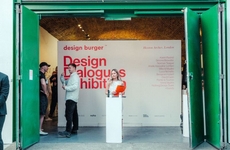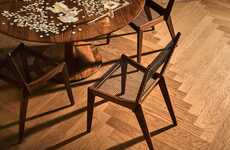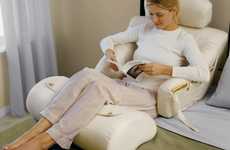
Tisah Tucknott — August 11, 2009 — Business
References: karimrashid
Karim Rashid is a renowned designer who has also written a book called ‘Karim Space,’ a popular and personal guide to living.
Karim Rashid has been the recipient of multiple awards, the latest from Veuve Clicquot Globalight called the Popai Gold Medal for Technics and Innovation. Along with Veuve Clicquot, Karim has also worked for Swarovski, LaCie and Samsung, among many others.
10 Questions With Karim Rashid
1. How did you get involved in design and what motivates you to continue?
My career really started in 1993 (when I was 33) when I moved to New York City. In my early 20s I spent two years in Italy doing post-graduate classes and working in Milano in a design office. That experience made me realize that I wanted to design poetic artistic yet functional everyday objects for everyday life.
But on my return to Canada from 1985 to 1991, I worked in a design office in Toronto for six years doing really ‘hardcore’ industrial design projects like machinery, medical equipment, power tools, laser measuring devices, snow shovels, train interiors, and mailboxes for Canada Post. I was disillusioned about the profession and felt that Italy was about the only country that understood the necessity of beauty in industrial design.
The North American companies were disrespectful of design. Design was not embraced as it is today. I went into being a full-time academic and stopped designing for two years because I was so fed up with industrial design. I was full-time in Toronto at OCAD, then the Rhode Island School of Design (RISD).
I was going to quit the profession in 1992 when I was fired from RISD. I was told I was teaching ‘philosophy and theory,’ not design. Then I found myself in New York City penniless and started drawing objects romanticizing about the beautiful world I always wanted to shape.
When I started my office, after approaching about 100 companies from La-Z-Boy to Gillette, I only got one client. I designed a collection of tabletop objects for Nambe in Santa Fe that became very successful. They sold about $3,000,000 a year and entered permanent museum collections.
This relationship gave me the confidence that I could really contribute some meaningful and successful objects into the world. I designed the OH chair and Garbo Waste can for Umbra (1995). They continue to sell millions and proved to me that Americans want design but at an affordable price.
I then went on to design cosmetic packaging for Issey Miyake, the Prada skincare line, cosmetics for YSL and Shiseido, products for Sony in 1998, and Giorgio Armani shops in 1999.
The first restaurant I designed was for Morimoto, the Iron Chef, in 2001 (Philadelphia) which fortunately won many awards. Being a successful restaurant interior designer afforded me many more interior projects including the Semiramis hotel in Athens. It was my first hotel, and I designed every aspect from the architecture to the flatware, from the menus in the restaurant to the staff’s uniforms. Since then I have designed thousands of objects and about 50 interiors.
This moment as I answer your questions I am working in 30 countries on about 50 projects and I feel like I am just starting. There is about 100 million dollars of my work sold yearly by about 200 companies globally. I think that I design objects that people love and want—not objects that are about design for design’s sake or insular design that is unfriendly and not coherent with people’s behaviors and sensibilities.
2. How significant are the topics of cool hunting and trend spotting in the world of writing or design?
I think what Trend Hunter does is necessary to expose the world to the ‘new’—to inspiring design and movements. Trend hunting is a preoccupation and need for many, but for me as a designer, I am working more in a first order, I am designing and shaping the future, not working off existing trends or styles.
My focus has never been about what’s cool or trendy. I do not look for trends and I never derive my work from trends. Design is about shaping new movements, finding new directions, new solutions, and new aesthetics, so design eventually shapes or results in trends. Design has been the cultural shaper of our world from the start. We have designed products, systems, cities, industrialization; we designed everything in the entire built environment.
3. How do you define a trend?
Trends for me are something that come and go, or are momentary, which is part of our ever-evolving, in flux world. But as a designer, if something is ‘trendy’ it means for me, it is over, it is style at that point, and no longer a movement or direction.
But frankly, I think we have blurred the meaning of trend, style, and design. Style is steeped in appropriating the past; design is about shaping the future. Trend is the populous embracement of the present.
4. How do you define cool?
Cool is smart, beautiful, poetic, original, individual, useful, sexy, enlightening, inspiring, contemporary, colorful, energetic, fulgent, powerful, and intellectual yet accessible.
5. Do you need a culture of innovation to create something that is cool?
Yes—I always believed that design and innovation should be inseparable. Style is separable from innovation, hence design has content, and style is fleeting and forever subjective.
Let me give you an example. I designed some shoes for a Brazilian company called Melissa. They asked me to design a high heel shoe. My first thought was to create a comfortable high heel shoe since I can’t believe that in the last 100 years we have continued to design uncomfortable high heel shoes. As far as I am concerned, there is no excuse.
So I used a tri-injection process to create a shoe made of three different inseparable polymers. One polymer is the unseen inside heel that almost moves and cushions (inspired by Nike Air concept). The sole polymer is extremely robust, and the overall shoe last is soft and very flexible polymer on the foot. Many women tell me it is the most comfortable high heel shoe they have worn. I also injected a scent in each shoe of vanilla, strawberry, etc.
The shoes are washable and remain looking perfect for years. This is an example of innovation and the result is an interesting unusual yet high performing object of design. I may sound like a braggart here but let me say that although this project is a successful example, for every success I have designed 10 failures!
6. What is the best way to create an infectious idea, product or service?
I write about this subject in my book “DESIGN YOUR SELF.” I would say question your life. Bring ideas, possibilities, opportunities, or even just alternatives to one’s life. With awareness we can then start to ‘resolve’ our problems which, at the end of the day, inspire individual control and self-confidence about taking charge of your life and your destiny.
My real desire is to see people live in a the modus of our time, to participate in contemporary world, and to release themselves from nostalgia, antiquated traditions, old rituals, meaningless kitsch, and that we should be conscious and sensorially attune with this world in this moment that we are alive.
7. What is the key to innovation?
Design’s agenda since the Industrial Revolution was to create accessible altruistic objects for a larger audience, so design’s agenda was to shape a betterment of society. And innovation affords this betterment. We live better today than we have ever lived historically, regardless of all the world’s problems.
I try to always have some level, even a nuance, of originality or innovation in my work, whether it is a new material, a new human behavior, new form, new production method, new market, new message (be it wit, humor, emotion, meaning, social or political agenda), new experiences, or completely new concepts.
Innovation is not about trends, it is not about problem solving, it is not about just form or just function—it is about progress. Innovation is the manifestation of brilliant new ideas that create progress and evolve humankind. To innovate is to be highly perceptive of the moment in which we live.
8. What are the most important trends you see in the design industry?
Trends are not important. I want to rid the world of nostalgia (NO-STALGIA!) so we can enjoy, celebrate and experience the contemporary world without perpetual biases and subjective tastes. I want to live only in contemporaneity.
It is comfortable for people to live with recognized vernaculars, with the security of known signs and languages. The past is easy to copy; the past, though, is pointless. We live, breathe, and engage today’s world.
A mobile phone is not a copy of the last, nor is a car or a fashion; therefore, all entities of our life should have this same agenda of high performance, new aesthetics, greater comfort, softer, more sophisticated and eloquent designs. You are alive today, so you should surround yourself with physical goods that are a reflection of our milieu.
The future trend will be immateriality. I think that the future is that we will own nothing (but have even more heightened, more digital experiences). This is really nature—a new digital nature. Now we lease cars, we lease houses, lease computers, and soon we will learn to lease everything, experience it for a short while, and go on to the next.
We will create a hyper consumptive, forever dynamic, ever-vast changing human condition, where everything will be cyclic, sustainable, biodegradable, and seamless. The digital age will be more human, more communicative, more active, more inspiring, and more experiential than ever. So if I design a physical object, it must at least try and speak and communicate this technological world in which we live.
9. Professionally, what do you want to be doing or studying in 10 years?
There is so much to do. I want to design an electric car, smart clothing, smart objects, houses, robots, buildings, restaurants and hotels, a hospital, a school, and I could go on and on. I want to keep designing products, cosmetics, furniture, lighting, interiors, producing art, and shaping the future.
I also have a desirous need to design objects for the physically challenged and the aging population. It is quite shocking how so few companies are addressing this ever-growing market. By 2012 there will be over 60 million Americans over the age of 60.
10. What are your most important hobbies?
Outside of design I always loved music, collecting music. So for the last 30 years I have deejayed around the world. So I do not really have a hobby. I always say that you should make your hobby your job.
Design is my lifelong hobby. Design is something that can be so emotional, so experiential, so romantic, so poetic, and so human and yet constantly moves us forward. We must evolve, we must innovate, and we must change. I want to change the physical world.
Karim Rashid has been the recipient of multiple awards, the latest from Veuve Clicquot Globalight called the Popai Gold Medal for Technics and Innovation. Along with Veuve Clicquot, Karim has also worked for Swarovski, LaCie and Samsung, among many others.
10 Questions With Karim Rashid
1. How did you get involved in design and what motivates you to continue?
My career really started in 1993 (when I was 33) when I moved to New York City. In my early 20s I spent two years in Italy doing post-graduate classes and working in Milano in a design office. That experience made me realize that I wanted to design poetic artistic yet functional everyday objects for everyday life.
But on my return to Canada from 1985 to 1991, I worked in a design office in Toronto for six years doing really ‘hardcore’ industrial design projects like machinery, medical equipment, power tools, laser measuring devices, snow shovels, train interiors, and mailboxes for Canada Post. I was disillusioned about the profession and felt that Italy was about the only country that understood the necessity of beauty in industrial design.
The North American companies were disrespectful of design. Design was not embraced as it is today. I went into being a full-time academic and stopped designing for two years because I was so fed up with industrial design. I was full-time in Toronto at OCAD, then the Rhode Island School of Design (RISD).
I was going to quit the profession in 1992 when I was fired from RISD. I was told I was teaching ‘philosophy and theory,’ not design. Then I found myself in New York City penniless and started drawing objects romanticizing about the beautiful world I always wanted to shape.
When I started my office, after approaching about 100 companies from La-Z-Boy to Gillette, I only got one client. I designed a collection of tabletop objects for Nambe in Santa Fe that became very successful. They sold about $3,000,000 a year and entered permanent museum collections.
This relationship gave me the confidence that I could really contribute some meaningful and successful objects into the world. I designed the OH chair and Garbo Waste can for Umbra (1995). They continue to sell millions and proved to me that Americans want design but at an affordable price.
I then went on to design cosmetic packaging for Issey Miyake, the Prada skincare line, cosmetics for YSL and Shiseido, products for Sony in 1998, and Giorgio Armani shops in 1999.
The first restaurant I designed was for Morimoto, the Iron Chef, in 2001 (Philadelphia) which fortunately won many awards. Being a successful restaurant interior designer afforded me many more interior projects including the Semiramis hotel in Athens. It was my first hotel, and I designed every aspect from the architecture to the flatware, from the menus in the restaurant to the staff’s uniforms. Since then I have designed thousands of objects and about 50 interiors.
This moment as I answer your questions I am working in 30 countries on about 50 projects and I feel like I am just starting. There is about 100 million dollars of my work sold yearly by about 200 companies globally. I think that I design objects that people love and want—not objects that are about design for design’s sake or insular design that is unfriendly and not coherent with people’s behaviors and sensibilities.
2. How significant are the topics of cool hunting and trend spotting in the world of writing or design?
I think what Trend Hunter does is necessary to expose the world to the ‘new’—to inspiring design and movements. Trend hunting is a preoccupation and need for many, but for me as a designer, I am working more in a first order, I am designing and shaping the future, not working off existing trends or styles.
My focus has never been about what’s cool or trendy. I do not look for trends and I never derive my work from trends. Design is about shaping new movements, finding new directions, new solutions, and new aesthetics, so design eventually shapes or results in trends. Design has been the cultural shaper of our world from the start. We have designed products, systems, cities, industrialization; we designed everything in the entire built environment.
3. How do you define a trend?
Trends for me are something that come and go, or are momentary, which is part of our ever-evolving, in flux world. But as a designer, if something is ‘trendy’ it means for me, it is over, it is style at that point, and no longer a movement or direction.
But frankly, I think we have blurred the meaning of trend, style, and design. Style is steeped in appropriating the past; design is about shaping the future. Trend is the populous embracement of the present.
4. How do you define cool?
Cool is smart, beautiful, poetic, original, individual, useful, sexy, enlightening, inspiring, contemporary, colorful, energetic, fulgent, powerful, and intellectual yet accessible.
5. Do you need a culture of innovation to create something that is cool?
Yes—I always believed that design and innovation should be inseparable. Style is separable from innovation, hence design has content, and style is fleeting and forever subjective.
Let me give you an example. I designed some shoes for a Brazilian company called Melissa. They asked me to design a high heel shoe. My first thought was to create a comfortable high heel shoe since I can’t believe that in the last 100 years we have continued to design uncomfortable high heel shoes. As far as I am concerned, there is no excuse.
So I used a tri-injection process to create a shoe made of three different inseparable polymers. One polymer is the unseen inside heel that almost moves and cushions (inspired by Nike Air concept). The sole polymer is extremely robust, and the overall shoe last is soft and very flexible polymer on the foot. Many women tell me it is the most comfortable high heel shoe they have worn. I also injected a scent in each shoe of vanilla, strawberry, etc.
The shoes are washable and remain looking perfect for years. This is an example of innovation and the result is an interesting unusual yet high performing object of design. I may sound like a braggart here but let me say that although this project is a successful example, for every success I have designed 10 failures!
6. What is the best way to create an infectious idea, product or service?
I write about this subject in my book “DESIGN YOUR SELF.” I would say question your life. Bring ideas, possibilities, opportunities, or even just alternatives to one’s life. With awareness we can then start to ‘resolve’ our problems which, at the end of the day, inspire individual control and self-confidence about taking charge of your life and your destiny.
My real desire is to see people live in a the modus of our time, to participate in contemporary world, and to release themselves from nostalgia, antiquated traditions, old rituals, meaningless kitsch, and that we should be conscious and sensorially attune with this world in this moment that we are alive.
7. What is the key to innovation?
Design’s agenda since the Industrial Revolution was to create accessible altruistic objects for a larger audience, so design’s agenda was to shape a betterment of society. And innovation affords this betterment. We live better today than we have ever lived historically, regardless of all the world’s problems.
I try to always have some level, even a nuance, of originality or innovation in my work, whether it is a new material, a new human behavior, new form, new production method, new market, new message (be it wit, humor, emotion, meaning, social or political agenda), new experiences, or completely new concepts.
Innovation is not about trends, it is not about problem solving, it is not about just form or just function—it is about progress. Innovation is the manifestation of brilliant new ideas that create progress and evolve humankind. To innovate is to be highly perceptive of the moment in which we live.
8. What are the most important trends you see in the design industry?
Trends are not important. I want to rid the world of nostalgia (NO-STALGIA!) so we can enjoy, celebrate and experience the contemporary world without perpetual biases and subjective tastes. I want to live only in contemporaneity.
It is comfortable for people to live with recognized vernaculars, with the security of known signs and languages. The past is easy to copy; the past, though, is pointless. We live, breathe, and engage today’s world.
A mobile phone is not a copy of the last, nor is a car or a fashion; therefore, all entities of our life should have this same agenda of high performance, new aesthetics, greater comfort, softer, more sophisticated and eloquent designs. You are alive today, so you should surround yourself with physical goods that are a reflection of our milieu.
The future trend will be immateriality. I think that the future is that we will own nothing (but have even more heightened, more digital experiences). This is really nature—a new digital nature. Now we lease cars, we lease houses, lease computers, and soon we will learn to lease everything, experience it for a short while, and go on to the next.
We will create a hyper consumptive, forever dynamic, ever-vast changing human condition, where everything will be cyclic, sustainable, biodegradable, and seamless. The digital age will be more human, more communicative, more active, more inspiring, and more experiential than ever. So if I design a physical object, it must at least try and speak and communicate this technological world in which we live.
9. Professionally, what do you want to be doing or studying in 10 years?
There is so much to do. I want to design an electric car, smart clothing, smart objects, houses, robots, buildings, restaurants and hotels, a hospital, a school, and I could go on and on. I want to keep designing products, cosmetics, furniture, lighting, interiors, producing art, and shaping the future.
I also have a desirous need to design objects for the physically challenged and the aging population. It is quite shocking how so few companies are addressing this ever-growing market. By 2012 there will be over 60 million Americans over the age of 60.
10. What are your most important hobbies?
Outside of design I always loved music, collecting music. So for the last 30 years I have deejayed around the world. So I do not really have a hobby. I always say that you should make your hobby your job.
Design is my lifelong hobby. Design is something that can be so emotional, so experiential, so romantic, so poetic, and so human and yet constantly moves us forward. We must evolve, we must innovate, and we must change. I want to change the physical world.
Trend Themes
1. Shaping the Future - Designing and shaping the future, not working off existing trends or styles.
2. Innovation and Progress - Innovation affords a betterment of society and progresses humankind.
3. Immateriality and Digital Nature - The future trend will be immateriality, where everything will be cyclic, sustainable, biodegradable, and seamless in the new digital nature.
Industry Implications
1. Industrial Design - Opportunities for disruptive innovation in creating everyday objects that are poetic, artistic, yet functional for everyday life.
2. Fashion and Cosmetics - Innovation opportunities in cosmetic packaging, skincare, and fragrance products that combine functionality and design at an affordable price.
3. Hospitality and Interior Design - Designing restaurant interiors, hotels, and other interior spaces that are smart, beautiful, and create an experiential and technologically-driven environment.
5.4
Score
Popularity
Activity
Freshness























